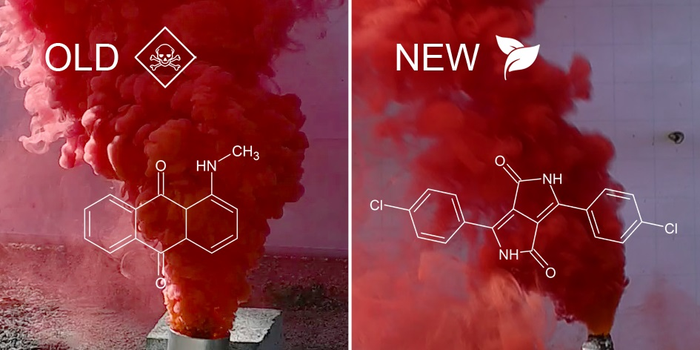The red smoke of a flare on a roadway warns motorists to be cautious, but the anthraquinone dyes currently used to produce this smoke are thought to be harmful to human health. Now, researchers reporting in ACS Sustainable Chemistry & Engineering have identified a less toxic, “greener” alternative — an organic dye called pigment red 254 (PR254). It also forms a red-colored smoke cloud more effectively than current dyes, the researchers say.

Credit: Adapted from ACS Sustainable Chemistry & Engineering 2022, DOI: 10.1021/acssuschemeng.2c01000
The red smoke of a flare on a roadway warns motorists to be cautious, but the anthraquinone dyes currently used to produce this smoke are thought to be harmful to human health. Now, researchers reporting in ACS Sustainable Chemistry & Engineering have identified a less toxic, “greener” alternative — an organic dye called pigment red 254 (PR254). It also forms a red-colored smoke cloud more effectively than current dyes, the researchers say.
Commercialized in 1986, diketopyrrolopyrrole (DPP) dyes are used as colorants in car paints (such as the famous “Ferrari red”), optics technologies and other applications. For the purpose of signal smokes, Vojtech Pelikan and colleagues chose the DPP dye PR254, which has a brilliant red color and is less toxic than anthraquinone dyes. In experiments, the researchers showed that a PR254-containing pyrotechnic composition reached a yield of red-colored smoke of 51%, compared with only 48% for the usual anthraquinone dye. PR254 was also more thermally stable than the reference dye, which might allow it to be used in a less toxic heat-generating system, according to the researchers.
The authors acknowledge funding from the University of Pardubice.
The American Chemical Society (ACS) is a nonprofit organization chartered by the U.S. Congress. ACS’ mission is to advance the broader chemistry enterprise and its practitioners for the benefit of Earth and all its people. The Society is a global leader in promoting excellence in science education and providing access to chemistry-related information and research through its multiple research solutions, peer-reviewed journals, scientific conferences, eBooks and weekly news periodical Chemical & Engineering News. ACS journals are among the most cited, most trusted and most read within the scientific literature; however, ACS itself does not conduct chemical research. As a leader in scientific information solutions, its CAS division partners with global innovators to accelerate breakthroughs by curating, connecting and analyzing the world’s scientific knowledge. ACS’ main offices are in Washington, D.C., and Columbus, Ohio.
To automatically receive news releases from the American Chemical Society, contact
[email protected].
Follow us: Twitter | Facebook | LinkedIn | Instagram
Journal
ACS Sustainable Chemistry & Engineering
DOI
10.1021/acssuschemeng.2c01000
Article Title
Diketopyrrolopyrrole — A Greener Alternative for Pyrotechnic Smoke Compositions”
Article Publication Date
30-Mar-2022




